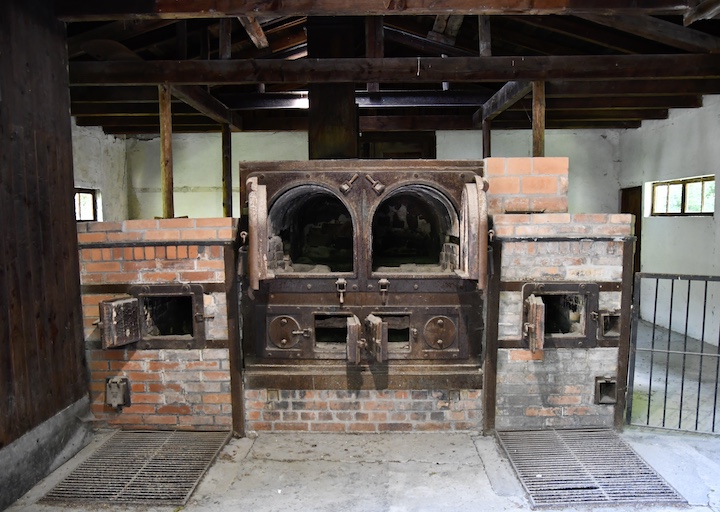
Its crematorium makes Dachau Concentration Camp Memorial Site one of the darkest tourism sites you can visit. Photo by Teresa Bitler.
By Teresa Bitler
Most visitors to Dachau Concentration Camp Memorial Site arrive today just as the prisoners did in the 1930s, by train. But instead of marching under the watch of SS guards, visitors board a city bus that takes a residential route past steep-roofed homes, a spattering of businesses and restaurants, and a school. The bus roughly follows the city’s Path of Remembrance from the train station to the memorial site’s visitors’ center. From there, they walk to the SS guardhouse, most unaware that they are participating in dark tourism.
Between 1933 and 1945, more than 200,000 prisoners passed through an iron gate reading, “Arbeit Macht Frei” (“Work sets you free”), at the guardhouse. Of those, scholars believe at least 40,000 died in the camp, many either shot by a firing squad or murdered in the gas chamber. The death and horror experienced at Dachau make it a prime example of this growing sector in the tourism industry.
What is dark tourism?
Simply put, dark tourism is visiting places associated with death, tragedy and suffering. This form of tourism emerged in the mid-1990s when academics John Lennon and Malcolm Foley first coined the term, but people have traveled to such places for as long as tourism has existed. In a 2017 paper, Lennon points out that ancient Romans attended gladiatorial exhibitions where combatants often died, and Manassas, Virginia, the site of the first battle of the Civil War, was sold as a potential tourist attraction the day after fighting ended.
Today, dark tourism is a $32.5 million industry worldwide, a figure Credence Research projects will increase to nearly $57 million over the next 10 years. It includes death sites, disaster scenes, sites of mass or individual death, sites of incarceration, “representations or simulations associated with death,” and re-enactments of death, according to Lennon.
Concentration camps like Dachau or Auschwitz and memorials like the 9/11 Memorial & Museum are classic examples of dark tourism. So are decommissioned prisons like Alcatraz Island in San Francisco Bay and burial sites like Recoleta Cemetery in Buenos Aires, the Paris Catacombs and Mount Moriah Cemetery in Deadwood, SD where Wild Bill Hickok and Calamity Jane are buried.
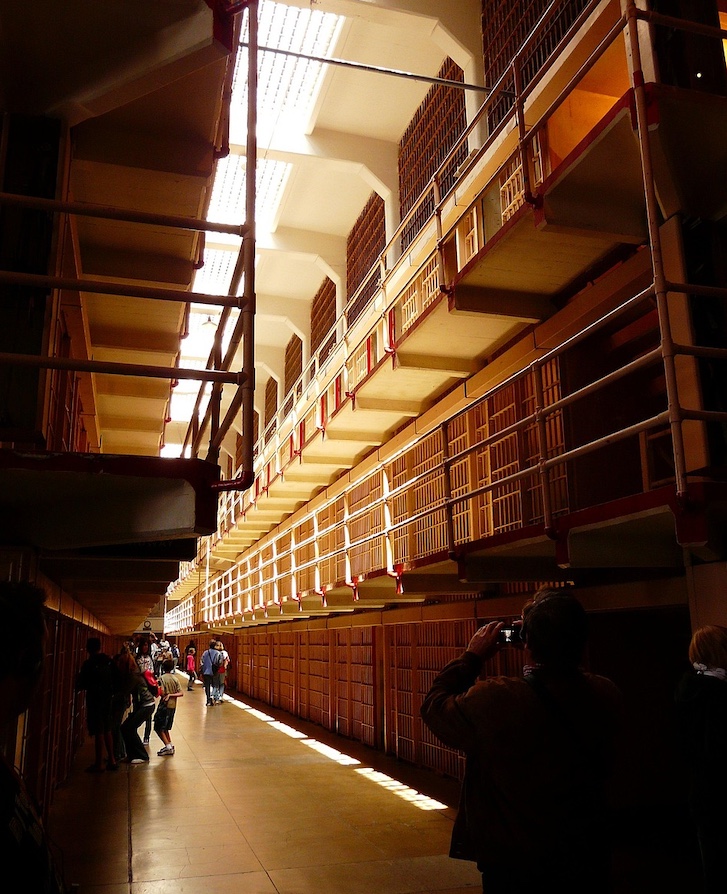
Most dark tourism experts agree that decommissioned prisons like Alcatraz Island in the San Francisco Bay are dark tourism sites. Photo by LoggWiggler/Pixabay.
Lennon counts battlefields as dark tourist spots, and Jason Martz, communications specialist for the Gettysburg National Military Park, agrees. After all, at least in the case of Gettysburg, the entire battlefield is essentially a cemetery, Martz says.
Although not a cemetery, the Sixth Floor Museum in Dallas qualifies because it documents President John F. Kennedy’s assassination and is located in the Texas School Book Depository, where Lee Harvey Oswald took the fatal shot that killed him. In Paris, the Flame of Liberty, which marks where Diana, Princess of Wales, died in a car crash in the tunnel below, has become a dark tourism destination.
The list goes on. Sites associated with the Cold War and abandoned nuclear facilities fall under the dark tourism umbrella. (Chernobyl was a popular dark attraction until the Russian-Ukrainian War forced tours to end.) Natural disaster sites like Pompeii and Herculaneum, plus other places associated with genocide, such as the Kigali Genocide Memorial in Rwanda, count, too.
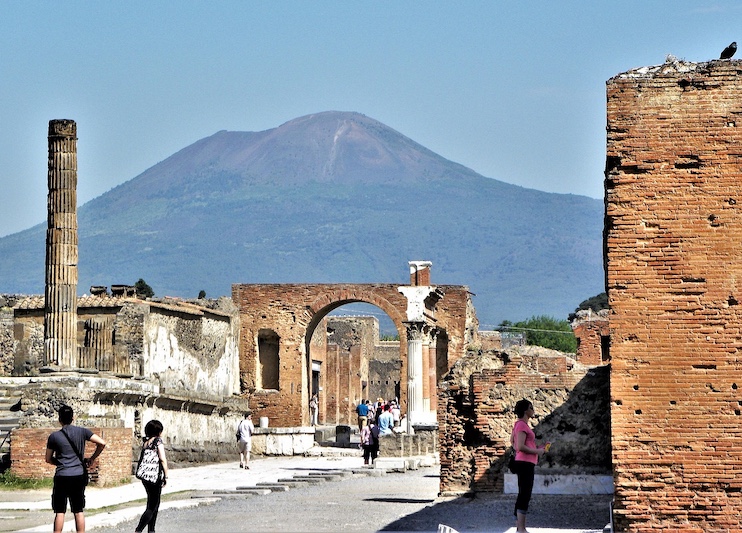
Pompeii is an example of a dark tourism site created by a natural disaster, in this case the erruption of the Mount Vesuvius volcano. Photo courtesy of mmillswan/Pixabay.
In a talk on dark tourism, travel and tourism educator Dr. Hayley Stainton says so many destinations and attractions fit the definition that we have all likely been dark tourists at one point or another without even knowing it.
Blurred edges
The further removed from these core sites, the more experts dispute what constitutes dark tourism. Peter Hohenhaus, author of Atlas of Dark Destinations, explains that while everyone agrees Auschwitz and the 9/11 Memorial & Museum are dark tourism sites, some people include ghost tours, ghost towns such as Bodie in California’s Eastern Sierras and Disneyfied dark places, like The London Dungeon. He doesn’t.
With a few exceptions, he also sticks to modern events when adding places to his website to align with Lennon and Foley’s assertion that the media creates an interest in these places. Jack the Ripper is a good example, Hohenhaus says. The infamous Whitechapel murderer wasn’t the first serial killer, but penny papers spread his story around the world. Now, as many as 35 guides nightly could be leading tours through Jack the Ripper’s hunting grounds.
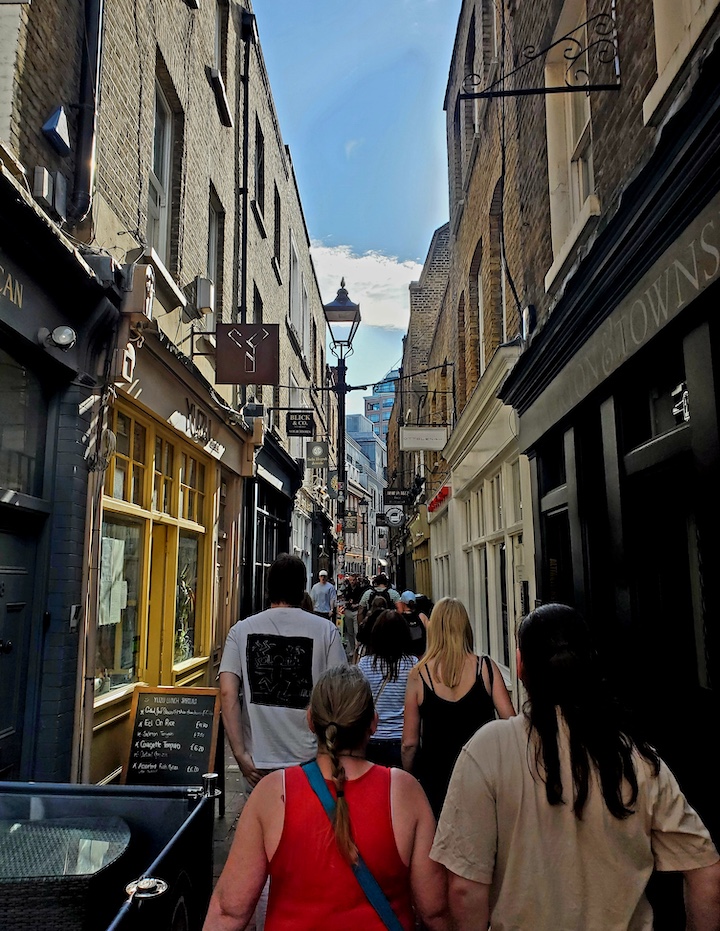
Tourists on a Jack the Ripper tour walk down a narrow street in Whitechapel learning about the unsolved murders plaguing London in 1888. Photo by Teresa Bitler
While the tours recount the murders through vivid storytelling and sometimes graphic photographs, they also delve into the extreme poverty of London’s East End at the time, adding to the dark aspects. Guides stop at what used to be “Ye Frying Pan” pub to discuss prostitution and alcoholism and point to a building that used to serve as lodging house where the poor slept on lice-infested beds.
“The macabre side of history is always going to attract people,” explains Sinead O’Leary, a London by Foot guide.
Although dark tourism usually encompasses true crime tours and murder sites, not everyone agrees with including them. Lawrenceburg Anderson County Tourism director Robbie Morgan says the 21 counties participating in Kentucky After Dark decided to exclude true crime so visitors didn’t approach victims’ families still in the area. Instead, the Kentucky dark tourism program focuses on ghosts, aliens and folklore, all things Hohenhaus refuses to include because he considers them fictional.
Despite the blurring, there is consensus on what dark tourism isn’t. Dark tourism isn’t anything “light.” It isn’t a day at the beach, a visit to the spa, or a foodie tour. It doesn’t include haunted houses with actors, abandoned amusement parks and shopping centers, film sets, active war zones or even sites that are necessarily scary or thrilling. It weighs heavily on you, forces you to think, and sometimes makes you cry.
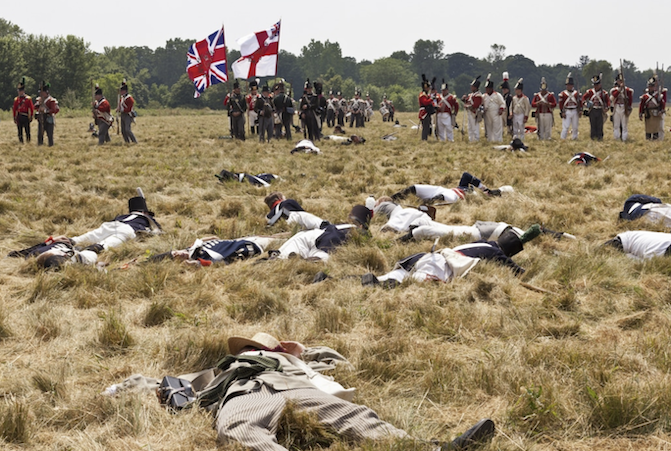
Every summer a reenactment of a pivotal War of 1812 battle takes place on Ontario’s Niagara Peninsula. Are the hundreds of spectators who come from both sides of the US-Canada border witnessing dark tourism or simply enjoying an outdoor theatrical production of President James Madison’s attempt to expell England from the American continent. At the time there were 7.7 million Americans and only 300,000 people living in Canada. When the war ended in December 1814, the border remained unchanged. In this recreated fight for control of Ft. George, the actors playing dead are all dressed like U.S. soldiers. Perhaps that’s because Canada is in charge of the reenactment. Photo by Cosmo Condina.
Why people visit
There’s no single reason why people visit dark tourism sites. On her website and in her TEDx talk, Stainton says she believes travelers primarily go to these places to learn about the past. As an added benefit, dark sites also often raise awareness of what led to a dark event happening. It’s hoped that if people learn the root causes, history won’t repeat itself.
Hohenhaus agrees that people seek dark tourism sites because they want to learn. “Dark tourism is generally one of the most educated forms of tourism, quite the opposite of escapism and getting away from it all,” he says. “It broadens one’s horizons and worldview more than any other form of travel I can think of.”
People also go for insight or understanding. Barak Yitzhaki, co-owner of Israel Wine Tour, sees this when he guides people to the Nova Music Festival Site Memorial and the city of Sderot, both of which were attacked by Hamas on October 7, 2023.
“The events of October 7th are so horrific, so difficult to wrap one’s mind around, that people want to try and make sense of it,” Yitzhaki says.
Place authenticity factors into dark tourism as well. Tourists want to see for themselves where a tragic event they’ve heard about, like the October 7th attacks, took place. (Some speculate the next big dark tourism destination might be Wuhan, China, ground zero for the COVID-19 epidemic.) Visiting dark tourism sites also gives visitors the opportunity to pay their respect to the victims even if they didn’t know them. The top tourism spot in Deadwood, SD, is Saloon No. 10, where Wild Bill Hickok was assassinated while holding a hand of aces and eights, which continues to be known 150 years later as the “Dead Man’s Hand.”
On the other hand, people may be drawn to true crime sites to feel a sense of empowerment, according to Bob Weiss, owner of Hangman Tours. While he believes the women who take his tour of serial killer Jeffrey Dahmer’s Milwaukee neighborhood do so for escapism, the tour also serves as a reminder that there is evil in the world. He hopes it inspires them to take safety precautions and be aware of their surroundings.
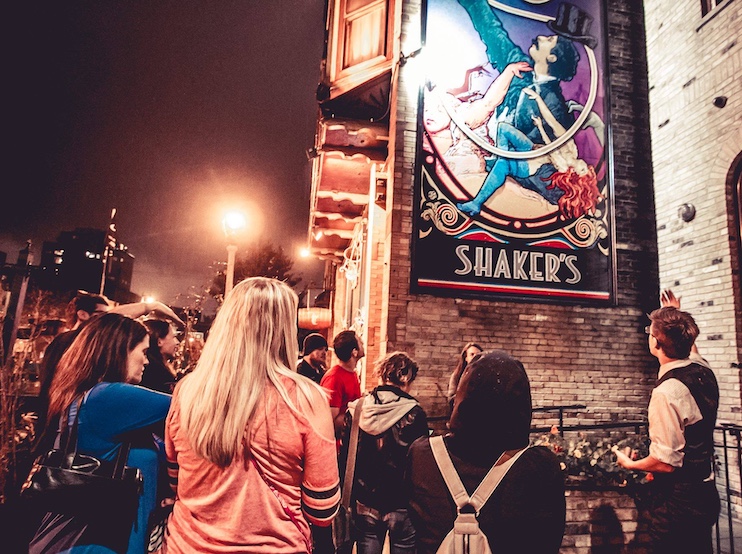
Women on a Cream City Cannibal tour of Milwaukee neighborhoods terrorized by serial killer Jeffrey Dahmer in the late 1980s, pause outside Shaker’s, a bar that Dahmer frequented. Photo courtesy of Hangman Tours.
Not all the reasons people visit have a positive spin. Some people are drawn to dark tourism sites because they want a new or one-of-a-kind experience. For example, The Last Meal Restaurant at the Ohio Museum of Horror serves the last meals requested by condemned prisoners, something you can’t do at other restaurants. Other people may go for likes, something sleeping in the bedroom where Lizzie Borden was accused of murdering her mother at The Historic Lizzie Borden House, now a hotel and museum, might provide.
How to visit
Regardless of the reasons why people choose to visit dark sites, some question whether anyone should visit the sites at all, saying dark tourism is the commercialization of grief. Others claim that it is a form of voyeurism, something academics adamantly deny.
Even worse, Lennon writes in his paper that dark tourism often stigmatizes a city. Dachau draws people to the concentration camp there, not to its Old Town or other sites. Similarly, in Snowden, Australia, the negative attention has been so intense after Erin Patterson murdered guests with poisonous mushrooms baked into Beef Wellingtons that the town is considering changing its name.
Hohenhaus points out that almost any form of tourism has the potential to do some kind of damage, though. Just flying to Europe produces carbon emissions that can impact the climate. However, dark tourism requires a higher level of respect than other forms of tourism. People should visit with a certain amount of solemnity to honor the suffering and death experienced in these places.
First and foremost, tourists to dark attractions shouldn’t laugh, talk loudly or have a light-hearted attitude. Second, experts agree that selfies are inappropriate, especially with a selfie stick, which draws attention to what you’re doing. If you must take a selfie, it should be expressionless.
Most importantly, open yourself to the significance of what happened at the site. Visiting a dark tourism site just might change you.
Teresa Bitler is an Arizona travel journalist who specializes in historic travel and now seeks out dark tourism experiences. Her previous stories for EWNS have explored Kentucky’s bourbon distilleries, Spain’s love of Jamón Ibérico and Johann Sebastian Bach’s life in Leipzig.

